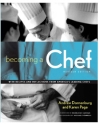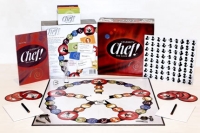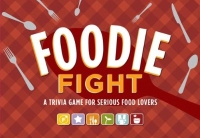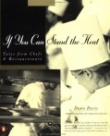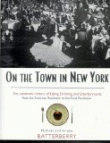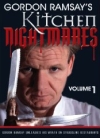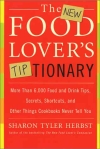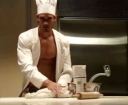The plot of this book, third in the 16 volume series, takes place at a luxury resort where Mon. P is on vacation. Pamplemousse finds himself ensconced at the world-renowned Les Cinq Parfaits. Sadly, Pommes Frites is denied entry to the dining-room. Undaunted, he sniffs his way to his own gastronomic nirvana -- with, dire consequences for all concerned. Unfortunately, the resort’s master chef has gone missing, which means that there will be no Souffle Surprise on the menu that night. Quelle disaster! Pamplemousse reluctantly strolls into action and while searching for the vanished cook uncovers an additional mystery at a local private school, which has a disturbingly high accident rate among its pretty female students.

| ©Copyright 2002-2008 [Shawn Nacol] All rights reserved |
Here are some Taste Buds appropriate books:
Gourmet biographies:
The Seasoning of a Chef Hot stoves, sharp knives, insanely long hours, low pay and no formal training—Psaltis pursued a relentless apprenticeship, parlaying each kitchen opportunity into another, including spending his few days off working unpaid in other restaurants, until he reached the culinary world's major leagues, working at Bouley Bakery in New York, the French Laundry in California and, most notably, for Alain Ducasse in New York and Monte Carlo, and as the original chef at Ducasse's restaurant Mix in New York. Written in the first person with assistance from his brother, Michael, Psaltis's story focuses on the professionalism and perfection required in the best restaurants. Like any great insider account, it brims with intriguing tidbits about various players and politics in the restaurant world, reveals some lesser-known practices and relays firsthand accounts of high-stakes mishaps and blunders. Details about the opulence and drive for excellence in the Ducasse restaurants, as well as Psaltis's opinionated account of practices in the "talent deficient" kitchen at the French Laundry are particularly eye-opening. Required reading for those considering culinary careers, this memoir is an appetizing indulgence for anyone who's ever wondered about the workings of a world-class kitchen. | |
by Bill Buford Buford's book starts smartly—he first met dynamic celebrity chef Mario Batali at a dinner party at his own home, where Batali sparkled until 3 a.m.—and continues at a fast clip as he conceives the notion of becoming Batali's "kitchen slave." Buford wanted to profile Batali for the New Yorker but also wanted to learn about cooking; he would be a "journalist-tourist" in the boot camp of a "kitchen genius." His subject became an obsession, and over the next three years, he investigated a rich menu of subjects: what makes a three-star restaurant work; what it takes to be a TV food star; the techniques and history of Italian cooking, not just from library research but also from repeated trips to Italy to visit Batali's relatives. Terrific culinary writing tracks Buford's successive passions for short ribs, polenta, tortellini and then the butcher's art, Italian-style, of pig and cow. Along the way, to his own surprise, Buford found that he had become a kitchen insider. This is a wonderfully detailed and highly amusing book from the writer who once took an insider's look at English soccer hooligans in his (DAZZLING!) Among the Thugs. | |
Becoming a Chef The updated edition of the book Julia Child called "a 'must' for aspiring chefs"-the James Beard Award-winning guide to one of today's hottest careers With more and more chefs achieving celebrity status, interest in the exciting world of today's leading chefs is higher than ever. Essential reading for anyone who loves food, Becoming a Chef gives an entertaining and informative insider's look at this dynamic profession, going behind the scenes to look into some of the most celebrated restaurant kitchens across the nation. More than 60 leading chefs-including some of the newest up-and-coming-discuss the inspiration, effort, and quirks of fate that turned would-be painters, anthropologists, and football players into culinary artists. | |
Kitchen Confidential Chef at New York's Les Halles and author of Bone in the Throat, Bourdain pulls no punches in this memoir of his years in the restaurant business. His fast-lane personality and glee in recounting sophomoric kitchen pranks might be unbearable were it not for two things: Bourdain is as unsparingly acerbic with himself as he is with others, and he exhibits a sincere and profound love of good food. The latter was born on a family trip to France when young Bourdain tasted his first oyster, and his love has only grown since. He has attended culinary school, fallen prey to a drug habit and even established a restaurant in Tokyo, discovering along the way that the crazy, dirty, sometimes frightening world of the restaurant kitchen sustains him. Bourdain is no presentable TV version of a chef; he talks tough and dirty. His advice to aspiring chefs: "Show up at work on time six months in a row and we'll talk about red curry paste and lemon grass. Until then, I have four words for you: 'Shut the fuck up.' " He disdains vegetarians, warns against ordering food well done and cautions that restaurant brunches are a crapshoot. Gossipy chapters discuss the many restaurants where Bourdain has worked, while a single chapter on how to cook like a professional at home exhorts readers to buy a few simple gadgets, such as a metal ring for tall food. Most of the book, however, deals with Bourdain's own maturation as a chef, and the culmination, a litany describing the many scars and oddities that he has developed on his hands, is surprisingly beautiful. He'd probably hate to hear it, but Bourdain has a tender side, and when it peeks through his rough exterior and the wall of four-letter words he constructs, it elevates this book to something more than blustery memoir. | |
The Kitchen Book & The Cookbook by Nicholas Freeling "Freeling will be read for a long time, because while he was turning his vegetables and reducing his sauces he had an eye to the social context of what he was doing, and to the rich ragout of Zola-esque characters by whom he was surrounded." --The Guardian Nicolas Freeling, best known for producing some of the finest of modern crime fiction, began his working life as an apprentice cook in a large French hotel. He continued cooking professionally for many years, and his enthusiasm for, and interest in, gastronomy in its broadest sense is at least equal to his passion for crime. Here, reprinted in a single volume, are his two splendid books of gastronomical memoir drawn from those experiences. Each is a delicious blend of the culinary and the literary, and include such recipes as cinnamon lamb stew and bouillabaisse, all charmingly floating about in a consistently entertaining text. The work is illustraited by the witty and winsome pen of John Lawerence, the perfect visual sauce for Freelin's savouries. Funny, wise, full of inspiration and delight, The Kitchen Book & The Cook Book will find a place close to every cook's hearth and heart. | |
The Making of a Chef: Mastering Heat at the Culinary Institute by Michael Ruhlman Journalist Michael Ruhlman talked his way into the CIA: the Culinary Institute of America, the Harvard of cooking schools. It had something to do with potatoes a grand-uncle had eaten deacades earlier, how the man could remember them so well for so long, buried as they had been in the middle of an elegant meal. Ruhlman wanted to learn how to cook potatoes like that--like an art--and the CIA seemed the place to go. The fun part of this book is that we all get to go along for the ride without having to endure the trauma of cooking school. Ever wonder what goes on in a busy kitchen, why your meal comes late or shows up poorly cooked? The temptation is to blame the waiter, but there are a world of cooks behind those swinging doors, and Ruhlman marches you right into it. It's a world where, when everything is going right, time halts and consciousness expands. And when a few things go wrong, the earth begins to wobble on its axis. Ruhlamn has the writerly skills to make the education of a chef a visceral experience. | |
The Perfectionist: Life and Death in Haute Cuisine What could possibly possess a three-star French chef, a master of his difficult trade in a country that reveres cuisine, to commit suicide in 2003, just after wrapping up the daily lunch service? Readers discover the reasons in a book so knowledgeable and breezily entertaining that it's easy to forget, while chuckling or salivating, that it's also something of an elegy to Bernard Loiseau of La Cote d'Or. Chelminski has lived in Paris for more than 30 years as a journalist, covering gastronomy, among other things, and is on schmoozing (and freeloading) terms with almost every chef in France; he first met Loiseau in 1974 when the 23-year-old chef was already winning notice. A high school dropout, Loiseau was an extroverted workaholic, clubby in the kitchen though shy with women, and a bipolar personality, obsessed with winning three stars in the venerable Michelin Red Guide. How he did it is a fascinating, discursive story. Readers learn what life was like for an apprentice (under the Troisgros brothers) in the 1960s in a kitchen that sounds near-medieval, and for a hot young chef in a chic Paris bistro in the '70s. Along the way (with droll footnotes), we're treated to a history of modern French cuisine, a look at how the Michelin family reached its gatekeeping apotheosis, encounters with dozens of chefs and many morsels of gossip. The pièce de résistance is the account of how Loiseau took a former three-star restaurant, demoted to none, back to triumphant stellar glory—and then what happened. |
Books about Celebrity Chefs:
TV Chefs: The Dish on the Stars of Your Favorite Cooking Show by Karen Lurie TV Chefs covers the whole spectrum of cooking shows---from PBS to TVFN to other cable outlets, and from the venerable (Jacques Pepin's Kitchen) to the wacky (Dinner and a Movie). It also features interviews with and/or profiles of twenty-five of today's most popular TV Chefs and food folks, including Mario Batali ("Mediterranean Mario), Julia Child (Baking with Julia Child). Graham Kerr (The Gathering Place), Martin Yan (Yan Can Cook), Micharl Lomonaco (Michael's Place), Susan Feniger and Mary Sue Milliken (Tamales World Tour), Emeril Lagasse (Emeril Live), Jennifer Paterson and Clarissa Dickson Wright (Two Fat Ladies), David Rosengarten (Taste), Amy Coleman (Home Cooking with Amy Coleman), Caprial Pence (Cooking with Caprial), Ming Tsai (East Meets West), Jaques Torres (Dessert Circus) and many others! | |
Backstage with Julia: My Years with Julia Child Author Barr (We Called It Macaroni) worked with culinary icon Julia Child for 24 years, starting in 1980 as an assistant to Child's monthly live segment on Good Morning America and remaining until Child's death in 2004. This delightful and sprightly backstage look at life with Child (a "Lucille Ball-with-a-rolling-pin character in the kitchen") describes Barr's work as an integral member of "the Julia team" that supported Child's "mind-boggling" schedule of demonstrations, media appearances and book signings. Barr skillfully illustrates Child's "extraordinary drive" in business, showing how "she never took her success or her audiences' acceptance of her work for granted," and how throughout her many ventures, "she maintained the integrity of what she was doing—teaching cooking." A delightful description of a day when the pair "gobbled down Double-Double burgers at the In-N-Out drive thru" illustrates how Child was "as down-to-earth, unguarded, and unselfconsciously outspoken in the company of friends as she was with the cameras rolling." By concentrating on the "memories of the Julia who was my mentor, my colleague, my friend; my story of what made her so special," Barr provides a sweet addition to Noel Riley Fitch's biography Appetite for Life and, recently, Child's autobiography with Alex Prud'Homme, My Life in France. | |
Don't Try This At Home: Culinary Catastrophes from the World's Greatest Chefs Food is fast becoming entertainment, so it's only natural that it should follow in the footsteps of sports and show business and offer up a collection of bloopers. Literary agent Witherspoon and food writer Friedman corralled 40 gastronomic heavyweights to share their versions of dinners gone wrong. The highlight is, unsurprisingly, the piece by chef and bestselling author Anthony Bourdain. His "New Year's Meltdown" is a case study in what happens when you don't plan (Bourdain admits, "Nobody likes a 'learning experience'—translating as it does to 'a total [a**-f******]'—but I learned"). Mario Batali's "The Last Straw," though not relating a culinary catastrophe per se, is runnerup: Batali was in culinary school when he clashed with a chef; in a spectacular crescendo, the chef hurled a pan of risotto at the young student, but revenge was sweet. But for every fantastic screwup, there's a dud. The translated pieces (such as the one by Spanish titan Ferrán Adrià) fail to captivate, and others, like Jimmy Bradley's tale about how he got drunk on the job to spite his boss, are neither entertaining nor instructive. Still, this collection happily reminds us that even big shots have off days. | |
Will Write for Food Passion is the theme of this informative guide focusing on the art of food writing. "Many food writers I've met are enthusiastic, intense, and energetic in an obsessive kind of way, and love nothing more than immersing themselves in research," writes Jacob, seasoned food editor and writer. The author devotes much of the book to outlining the elements of good writing, like finding one's own unique voice or knowing the most vivid adjectives to use in reviews. Covering all the various careers available in food writing, Jacob offers tips for creating a successful cookbook, writing recipes with clarity and even writing food-related fiction novels. The end of each chapter includes helpful writing exercises, allowing readers to put her advice to practice immediately, and the book also contains plenty of practical information (e.g., how much freelancers should expect to get paid). Less useful are the brief but generally uninteresting stories about how successful food writers got their start. Still, this comprehensive guide, though at times monotonous, is a great tool for anyone looking to make a career out of a love of food. | |
Do you have the recipe for success? Not everyone has what it takes to become a celebrity chef. Now in the comfort of your home, test your mettle and see if you can take the heat. Do you have the skill to: -Land a TV Show -Run a hot restaurant -Get product endorsements - Sign a cookbook deal -Be acclaimed in the press Celebrity Chef! The Game gives you your chance to: Impress your friends with your culinary know how by handling questions in Chef School, Tools & Techniques and The Bar. Challenge your friends in a round of Cook Off, or Name That Dish. Test your knowledge of Chef Pop Culture. Every time you play there can only be ONE true Celebrity Chef ... Is it YOU? | |
Calling all food lovers! This addictive trivia game allows players to strut their culinary stuff and prove who is the smartest foodie of them all. With over 1,000 questions on topics ranging from culinary science and celebrity chefs to food history and exotic cuisine, each player is bound to get a full serving of food knowledge. But think fast, because the first player or team to fill in their game board wins! Created by Joyce Lock, the owner of Stir, a culinary consulting firm. Foodie Fight not only entertains, it educates. The more than 1,000 questions are smart, informative and fun, spanning six categories: Foodiesphere (food people, world cuisines and food places), Food Stars (food on film and in print, music and art), Company’s Coming (party planning, table etiquette, and wine and food pairing), Lab and Field (cooking science, nutrition and food production), Dining Out (eateries, chefs, menu matters and restaurant service) and What’s Cooking? (cooking techniques, tools and ingredients). A great review of the game is available here: http://www.biteofthebest.com/foodie-fight-a-trivia-game-for-serious-food-lovers/
|
Restaurants & The Business of Food
by Courtney Febbroriello In this window into the life of a chef's wife, Febbroriello challenges the stereotype of such women as pampered-she doesn't like exotic foods, is a vegetarian, subsists on potatoes and yogurt gulped down on the run. Febbroriello tires of hearing how wonderful it must be to be the wife of cook Christopher Prosperi of Metro Bis in Simsbury, Conn., and complains of condescending businessmen who assume they need to talk to her husband when she herself is part owner. She details the manic organizational demands of owning a restaurant, customer complaints, crowded lunches, a husband to whom every surface is a napkin; she even dishes out raunchy kitchen jokes. After her experience as Fry-O-Lator girl in a restaurant that allowed workers to pick up food that had fallen on a floor frequented by cockroaches, Febbroriello vowed never to eat out again-that is, until she became enamored of her husband-to-be and his passion for all things food. With chapter titles like "Combat Skills" and "The Rules of the Jungle," the book makes one wonder why anyone would want to be in this business. There is only passing mention of the rewarding customers and quirky regulars, and with only one recipe, there is more evidence of passion for bookkeeping than there is passion for food. However, those who have suffered the indignities and long hours of the restaurant business will appreciate her no-nonsense descriptions of the fierce competition for the best ingredients, wines and employees; the politics of reviewing; the financial woes; and the customers who can't make up their minds.
| |
If You Can Stand the Heat: Tales from Chefs and Restaurateurs "Fantastic. Both professionally, as a chef, and personally, as a reader, I couldn't put this book down. I was drawn to these great portraits of passionate people who, though they come from diverse culinary backgrounds, share a common love for food." -- Marcus Samuelson, Executive Chef of Aquavit and winner of the 1999 James Beard Rising Star Chef of the Year Award This collection of career profiles of well-known chefs posits itself as a guide for those who fantasize about starting restaurants themselves. Chefs ask repeatedly: Have you got the stuff?. The family who founded Boston's French-Cambodian restaurant, the Elephant Walk, recounts a story of immigration and struggle. Harvard graduate Andrew Pforzheimer, who now owns three restaurants in Connecticut, trained, among other places, at a "jewel-box" restaurant (kitchen staffed by immigrants) in Beverly Hills, and Marc Jolis of Atlanta's Cafe Sunflower studied at a culinary school. None of the chefs makes the work sound easy, although Anthony Bourdain's tales of "snorting rails of coke that we'd run from one end of the bar to the other" may appeal to some. Davis includes informational sections such as a list of the 10 culinary schools with the highest enrollment and the top four reasons that restaurants fail, according to Gary Goldberg, director of the New School's Culinary Arts program. Each chef interviewed contributes one or more recipes (Marc Jolis's Sweet and Sour Lemongrass Saffronated Pasta with Apricots and Strawberries; Alan Wong's Grilled Lamb Chops with Macadamia-Coconut Crust, Cabernet Sauvignon Jus and Coconut-Ginger Cream), which are interesting but seem discordant with the body of this fairly encyclopedic vocational tool. | |
Flash in the Pan: Life and Death of an American Restaurant When "The Falls" opened in lower Manhattan in 1990 with all the pomp and press attention befitting a "hot" new trendy restaurant, no one imagined that it would close in little more than a year. The story of The Falls sadly typifies those dining-as-theater eateries where an artsy space, chic clientele, and modelesque service upstage the cuisine. Blum, a writer for Esquire , Vanity Fair , and The New Republic , offers a voyeuristic behind-the-scenes account of the intricacies of starting and running such an establishment. Filled with plentiful humor and satisfying anecdotes about the characters and events that make up the hip "downtown" New York scene, Blum's book is more an entertaining look at, rather than a serious dissertation on, the restaurant business. | |
On the Town in New York: The Landmark History of Eating, Drinking, And Entertainments from the American Revolution to the Food Revolution "A delightfully nostalgic look at some of the notable eating and drinking establishments and their celebrated clientele," said LJ's reviewer of this volume, which takes readers on a tour of such sites as Brodie's, Delmonico's, McSorley's, the Waldorf Astoria, and the Plaza Hotel. With most of the text covering 1860 to 1970, this book "is a portrait of changing American tastes, habits, and behavior" (Library Journal) This delightful, vividly detailed book takes you out "on the town" in New York from the American Revolution to today's Food Revolution. Michael and Ariane Batterberry, founders of Food and Wine magazine, detail a magnificent journey through the streets of New York, exploring the customs in eating, drinking and entertainment of both high and low culture. They take you into the dives of the Tenderloin and to the elaborate banquets of the Gilded Age. Whether they are talking about a saloon or the famous Astor House, they provide the most fascinating details from New York's richly diverse culinary history. | |
Multi-Michelin-starred chef Gordon Ramsay is back with his trademark mix of tough-talking and inspirational tough love style of leadership for another foray into some of Britain's scariest kitchens in a new, eight-part season of the BAFTA and International Emmy award-winning series. Moving, surprising, and inspiring, Ramsay's Kitchen Nightmares exposes viewers to the harsh reality of running a restaurant and reveals that there's always a chance for redemption even with the most unpromising and disastrous ingredients. This is a two DVD set featuring over three hours of gripping reality TV as the famed master chef (from the show Hell's Kitchen) attempts to save restaurants in crisis with tough love, elbow grease and his colorful use of the English language. Often intense and uncomfortable, Kitchen Nightmares is also very funny thanks to Ramsey and his no-holds-barred approach. n.b. The US version is irritatingly focused on sentimentality and quick-fix makeovers. Opt for the 5 seasons of the much superior UK version. |
Food & Recipes:
by Andrew Dornenburg and Karen Page If you really find food fascinating--the idea of food, working with food, and the eating of food--then Culinary Artistry should be on your bookshelf. There are two books at work here. One is What Chefs Have to Say About the Foods They Create. The other is Fun with Food Spread Sheets. A cynic might suggest that after putting together Becoming a Chef, the authors had so much leftover interview material that Culinary Artistry was but the natural outcome. The chef's point of view, however, would be to make use of everything passing through the kitchen, to throw nothing away. In other words, if Becoming a Chef is an entrée, then Culinary Artistry is the special of the day. The book is divided into sections that discuss and reach out to chefs to join in that discussion of such ideas as the chef as artist, dealing with sensory perception in food, composing with flavors, putting a dish together, putting together an entire menu, and standing back to admire the growth of a personal cuisine. This is thoughtful material. It is not how-to material. These guided conversations are made practical for the home cook by charts such as which foods are in season and when, the basic flavors of foods (bananas are sweet; anchovies are salty), food matches made in heaven (lamb chops with aioli or ginger or shallots), seasoning matches made in heaven (dill and salmon), flavors of the world (Armenia means parsley and yogurt), common accompaniments to entrées (beef and potatoes), and, most fun of all, the desert-island lists of many of the chefs quoted so extensively throughout the text. Many recipes accompany the text. | |
The Flavor Bible: The Essential Guide to Culinary Creativity, Based on the Wisdom of America's Most Imaginative Chefs by Andrew Dornenburg and Karen Page Dornenberg and Page's follow up to their award-winning What to Drink With What You Eat certainly compliments its predecessor (part of the intent), but works equally well as a standalone reference for cooks of all skill levels. An alphabetical index of flavors and ingredients, the book allows readers to search complimentary combinations for a particular ingredient (over 70 flavors go well with chickpeas; over 100 are listed for oranges), emphasizing the classics (chives with eggs, nutmeg with cream, sardines and olive oil, etc.). Entries for ingredients such as chicken, beets and lamb span multiple pages and feature menu items from chefs such as Grant Achatz of Alinea, Alred Portale of Gotham Bar and Grill and Le Bernardin's Eric Ripert. Regional tastes are well-represented in broad entries for classic German and English flavors, as well as the more fine-tuned flavors of, for example, northern France or West Africa. The listings, combinations and short essays from various chefs on different matches are meant to inspire rather than dictate-there are, in fact, no recipes included. Instead, the volume is meant as a jumping-off point for those comfortable in the kitchen and eager to explore; though experienced cooks and chefs will benefit most, novices will find themselves referring to this handsome volume again and again as their confidence grows.
| |
The New Food Lover's Companion (4th Edition) by Sharon Tyler Herbst & Ron Herbst The brand-new fourth edition of this widely praised reference guide has been updated with new information for everyone, including lovers of ethnic foods and health food aficionados. The authors have added many all-new entries on exotic produce and other unusual ingredients. An earlier edition of The New Food Lover’s Companion was hailed by Bon Appetit magazine as “one of the best reference books we’ve seen, a must for every cook’s library.” This new edition has even more to offer! Among the myriad foods and culinary subjects defined and explained are cooking tools and techniques, meat cuts, breads, pastas, international foods, cheeses, eggs and omelets, herbs and spices, fruits and vegetables, candies and desserts, wines and cocktails, and literally everything else related to good food and enjoyable dining. Handy and helpful appendices cover a wide range of food-related topics. They include suggestions for substituting recipe ingredients, high-altitude baking adjustments, a microwave oven conversion chart, recommended safe cooking temperatures for various meats and fish, a guide to reading food package labels, seasoning suggestions to enhance favorite dishes, a food additives directory, and much more. The New Food Lover’s Companion is a reference guide—not a cookbook—but it includes hundreds of cooking tips plus an extensive bibliography of recommended cookbooks and other food-related literature. Here in one volume is an invaluable companion for cooks—and for everybody else who loves good food. More than 6,700 entries plus line art that shows retail cuts of lamb, pork, beef, and veal. |
|
The New Food Lover's Tiptionary by Sharon Tyler Herbst Both experienced and novice cooks will love this A-to-Z guide packed with more than 6,000 tips, shortcuts and other culinary wisdom cookbooks never tell you. Find all the answers you'll ever need to a universe of cooking quandaries and questions on hundreds of subjects, including foods, beverages, kitchen equipment, cooking techniques, entertaining ideas and smart ways to use leftovers. Plus, there are loads of quick and easy reference charts, a handy system of cross-referencing and well over a hundred shorthand-style recipes. | |
by Wolfgang Schivelbusch A lavishly illustrated, anecdotal survey of all of the substances we chew, drink, or inhale for pleasure and how they were discovered and adopted by humankind. The book shows in fascinating detail how each stimulant, spice, or intoxicant served a particular need for an individual culture and how each, in turn, affected that culture and its behavioral norms. There is no index, but the table of contents is extensive, making it both an effective research tool and an enjoyable source of recreational reading. It provides a refreshingly light-hearted, yet engaging glimpse at some of the substances which, through our stomachs, lungs, and palates, have played a not insignificant role in personal and cultural interactions of European civilizations. Concentrating primarily on western societies between the sixteenth and nineteenth centuries, Schivelbusch devotes over 50 pages to each of the subjects of coffee, tobacco, and alcohol; he also includes ample discussion of the historical role of chocolate, spices, and nineteenth-century opiates. Over 100 black-and-white reproductions of period art enhance Schivelbusch's lively discussion of the material. Without suggesting that these substances played an unrealistically inflated role in history, Schivelbusch offers a highly accessible discussion equally suitable for the student or casual reader | |
Good to Eat: Riddles of Food & Culture by Marvin Harris Why are the world's food habits or "foodways," as Harris refers to them, so diverse? In this scholarly yet fast-paced and very readable work, anthropologist Harris argues that "major differences in world cuisines can be traced to ecological restraints and opportunities which differ from one region to another." He explores varied cultural phenomena including preoccupation with meat-eating; avoidance of killing cows among Hindus; Jews' and Moslems' abomination of pork; American's aversion to horsemeat; Southeast Asians' loathing of milk; avoidance of eating insects and pets; and cannibalism all having, in Harris's interpretation, a rational basis in circumstances, costs, and benefits, rather than stemming from arbitrary symbolism. This well-documented book is entertaining as well as informative, and both laypersons and scholars will find it of interest. |
Delicious culinary fiction...
High Bonnet: A Novel of Epicurean Adventures | |
Someone is Killing the Great Chefs of Europe by Nan Lyons & Ivan Lyons A witty tongue-in-cheek satire of the gourmet scene in general, more specifically the intense rivalry between the cream of the culinary creative. You know, kind of chefs who've perhaps written a book or two, but (beside Jacques Pepin) would never suffer the indignity of having their precious secrets revealed on the small screen. This is Guide Michelin meets murder. A saucy, sexy, 70s mystery that's well worth reading before you crank up the delightful film adaptation starring Jacqueline Bisset, George Segal, and the inestimable Roger Morley. This culinary comedy classic was adapted impeccably by screenwriter Peter Stone, famous for Charade. Beautiful European locations, exquisitely filmed by photograper John Alcott, and a great score by Henry Mancini. | |
La Bonne Table The gifted and exuberant Ludwig Bemelmans was trained as a boy for a career as a restauranteur, and La Bonne Table is in effect his gastonomical autobiography. The high - and sometimes riotous low - points of his life with food, from Austrian cafes to the late, lamented Ritz of New York, are narrated with delight and zest as he celebrates beer and sausages, pressed duck and caviar, and the chefs who cooked for him. He remembers with decidedly mixed emotions the ways of the busboy and the waiter, and the qualities that make up the perfect maitre d'. He muses over great menus and great eaters - and soon makes the reader very hungry. Here, truly, is a feast of reading, as a lost world of luxury and elegance is brilliantly evoked and savored. Bemelmans' extraordinary charm captivated all who met him; it glows through the pages of La Bonne Table. | |
The Monsieur Pamplemousse Series by Michael Bond "An engaging mix of farce, detection and fine cuisine' The Times 'Monsieur Pamplemousse and his faithful dog Pommes Frites are true and original comic inventions." The Guardian "As light and naughty as a spiked creampuff . . . a bawdy romp in a French accent." Houston Post. Monsieur Pamplemousse works as an inspector of hotels and restaurants for the illustrious Le Guide, the definitive word on sacred French cuisine at its most haute. Pamplemousse’s boss, le Directeur, Henri Leclercq, embroils Monsieur Pamplemousse in one seething scrape after another. Luckily, his faithful canine companion, Pommes Frites, stands ready to help, whether sharing the delectable dishes or outwitting criminals in and out of the kitchen. Monsieur Pamplemousse, a restaurant critic for exacting culinary report Le Guide, visits a fine country inn, where the excellent chef may be in line to receive the coveted—and elusive—third Stock Pot in the prestigious Guide. M. Pamplemousse does not expect to be disappointed at the fine restaurant, but he certainly gets his fill of surprises... including a head in his dinner. From the over-salty sauce, to most peculiar dishes, to a mysterious man with two iron hooks to the most ominous of all—Madam Pamplemousse herself—the culinary inspector and former agent of the Sûreté is confronted with mysteries and dangers. Monsieur Pamplemousse On The Spot Monsieur Pamplemousse And The Secret Mission Monsieur Pamplemousse, the ex-Sûreté detective turned undercover food critic, and his discerning canine companion, Pommes Frites, are back in another bawdy, rip-roaring tale. At the express wish of the director of the food guide he works for, Pamplemousse and friend leave their Paris base and head for the Loire, a region famed for its fine wines and haute cuisine, to investigate strange doings at the Hotel du Paradis. The establishment apparently cares little about the comfort of its guests, and even less for their tastebuds, as the gastronomic sleuth learns when he samples the ghastly fare. However, the food has one redeeming quality it is highly aphrodisiacal. Its effect on master and dog leads them both into adventures of a most indiscreet kind, as Pamplemousse becomes hopelessly entangled with a girls' marching band, encounters an unknown assailant who keeps bopping him with baguettes, and engages in an ongoing battle with a public pay toilet while Pommes Frites runs amok among the female canine population. Once again, Bond, creator of Paddington Bear, creates a delightfully wacky world where logic takes a back seat to bubbly dionysian pleasures. Monsieur Pamplemousse Hits The Headlines During his time as an inspector with the Paris Sûreté , Monsieur Pamplemousse had been "in at the death" on more than one occasion; but the phrase took on an entirely new meaning when he was present at the spectacular ending to Cuisine de Chavignol, France's premier television cooking program. Seated in the front row, he watched in silent horror as the host, having downed an oyster in close-up, uttered a strangled cry and slowly but surely disappeared from view behind a kitchen worktop. As screens across France went blank, hands reached for the telephone and the media swung into action. Eyes glued to the Pamplemousses television, Pommes Frites, dog extraordinaire, has his own views on the matter. Claude Chavignol was a bad egg if ever he d seen one, and in his experience villains seldom came out smelling of roses. Subsequent events prove him right as usual, but not before both he and his master find themselves caught up in a bizarre world of unrequited lust, murder and blackmail in high places. | |
by Peter King Another culinary mystery series written with foodies in mind. This series debut by a Cordon Bleu chef leads readers on a cook's tour of haute cuisine, replete with tantalizing descriptions of food and its preparation, robust wit and an appropriately culinary murder. London's "Gourmet Detective," whose business is "locating rare and exotic foods, advising on substitutes for scarce products, finding alternate sources of ingredients," is hired by Francois Duquesne to find out who is sabotaging his famous restaurant by confiscating shipments of food and planting mice in the larder. The unnamed detective, who narrates the tale, is in attendance at the prestigious Circle of Careme banquet at Francois's restaurant when an influential TV journalist is poisoned. Asked to assist in the investigation by Scotland Yard's Food Squad inspector, the Gourmet Detective traces the media-steeped case to its conclusion. King serves up an entertaining puzzle as his hearty main course, rounding out the offering with food facts, references to mystery literature and exotic ingredients (among them ortolans and turbot) and snappy one-liners. The hero declares at the end that he's had enough of murder and will stick "with mangoes and marjoram from now on." Readers will hope he doesn't mean it. |
Other things to consider...
Joseph Mitchell's Up in the Old Hotel.
Read the old masters: Escoffier, Bocuse et al as well as the Young Turks: Keller, Marco-Pierre White, and more recent generations of innovators and craftsmen.
|



